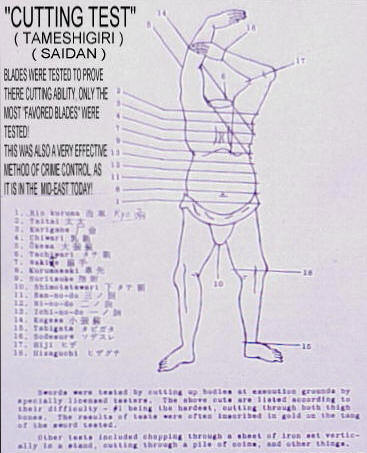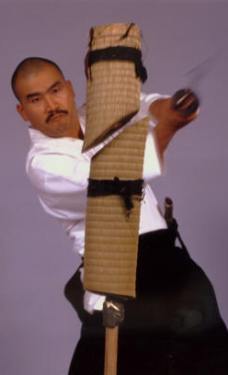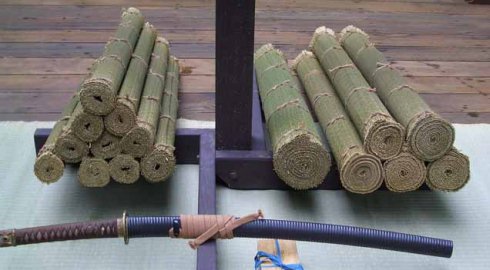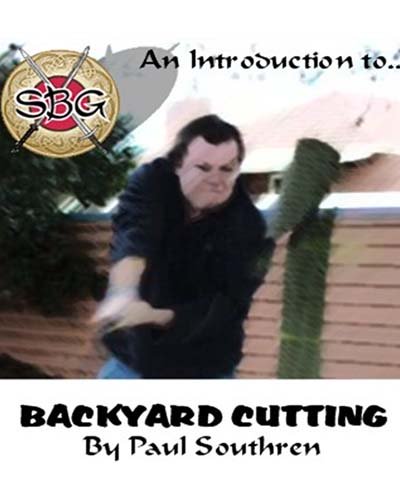Recent Articles
-
Christmas Sword Buying Guide 2025
Dec 03, 25 10:53 PM
An Introduction to Tameshigiri
試し切り
Many people who say they do Tameshigiri are really just having fun with swords cutting stuff up or 'Backyard Cutting' - but it's really not the same thing... Not by a long shot.
In this article, we take a look at what this aspect of the Japanese Sword Arts is REALLY about including its somewhat gory history, the targets used, basic and advances techniques and some resources to help you learn how to do it the right way...!
Grim Origins
From Human Bodies to Tatami Mats

The first targets for tameshigiri were, as you can probably guess from the title, human bodies. Specifically, the bodies of executed criminals cut into pieces as shown in the chart to the right (that looks disturbingly like a butchers prime cuts meat guide!)...
For particularly fine swords, often multiple bodied were tied together - with one old Japanese sword recording on the tang it successful cut through the spines of 7 bodies piled together (which is the record incidentally)...
SIDE NOTE: It is interesting to note that the bodies were carefully inspected before cutting to check for disease, primarily because it was believed that sickness would make the pure sword unclean, and for this reason the swords were never tested on low caste individuals or priests, as this was believed to warp the blades soul.

Anyway, after each such gruesome cut, the sword and the target were carefully examined to determine if the edge had notched and that the cuts were clean. To ensure that it was a test of the sword itself and not the man wielding it, only the most skillful swordsmen performed these tests to minimize the variables between one swordsman and another.
It was during a transitional time in the Meiji period that inevitably, with the modernization of Japan, test cutting on criminals became illegal and was replaced by soaked and bound wara (rice straw) with a bamboo core in which side by side tests found to be almost the same density and consistency as the original human targets...
While wara are still widely used in Japan, the innovative modern day Samurai (and my early boyhood hero) Toshishiro Obata (pictured right) is credited with finding rice mats difficult to obtain in the US and as a result did some testing to find a more easily obtainable substitute with the same consistency as Wara.
And found it in the form of Tatami Omote, also known as Goza...
Tatami Omote
畳表

These days, Tatami Omote is easily the most common medium for dojo approved Tameshigiri. Consisting of the outer covering (Omote) of the Tatami mat used in Japanese homes, a single rolled tatami mat over a bamboo core is supposedly extremely close in consistency to that of a human arm or neck which is very scary when you see how easily some swords cut right through it...
VIDEO: REAL Tameshigri
My childhood hero, Soke Toshishiro Obata, demonstrating how tatami is REALLY cut.
The most commonly used Tatami mats used in JSA circles tend to be from Mugen Dachi primarily because they are the most consistent and highly regarded as the best quality mats in the business. (I also use them myself, as when it comes to comparing the results of test cutting on my site, I need to be sure that the only variable is the sword. My own technique is consistently bad, and the mats consistently good so if I can cut with a particular sword, I would at a guess say anyone with a modicum of training can do it too!).
No matter where you get them from, preparing the mats is quite easy. Simply roll them up, leaving enough space inside to insert a small wooden dowel on the cutting stand, tie them off and soak them for 16 to 24 hours, allowing them to dry off for 20 mins or so before cutting.
Cutting Techniques
These days, Tameshigiri is often used as a test of the swordsmans skill - and is also practiced extensively in the Korean sword arts.
Not only does Tameshigiri measure the speed, blade angle (hasuji) and power of the swordsman but in the words of Obata Soke without it, neither the physical (stance, cut and grip) or mental (spirit, determination, resolve) elements of swordsmanship can be learnt or evaluated and the result is the empty and meaningless movement that typifies so many modern forms of martial arts.
As opposed to casual backyard cutting true Tameshigiri follows set patterns and is highly ritualized, both for safety and to cultivate zanshin (spirit) before, during and after the cut. Below is a video showing exactly how detailed and ritualized Tameshigiri can be...
VIDEO: Ritualistic Cutting
The true spirit of Tameshigiri.
The next video shows the somewhat more dynamic and visually exciting forms practiced within the Korean Gumdo art.
VIDEO: Dynamic Korean Gumdo
More fun, less meditative, more contemporary.
It's very different than Japanese Tameshigiri (and to be honest, they do a LOT more cutting than most Japanese Sword Arts). But definitely looks like good fun.
FREE EBOOK FROM SBG!
Considering the availability of decent functional low priced swords and Tatami mats it is really no surprise that people from all walks of life are doing what you might call backyard tameshigiri.
Generally speaking, I do not personally recommend or endorse this course of action and strongly recommend to anyone who wishes to do it to join a club that has tameshigiri as an integral part of their curriculum Toshishiro Obatas' Shinkendo clubs and those of the Korean Gumdo arts immediately spring to mind...
However, for responsible adults who are brave and/or foolhardy enough to try their hand doing it without the benefit of an instructor, my free PDF ebook A beginners guide to backyard cutting, while not strictly Tameshigiri per se, is a good introduction to this sport.
Further Resources
For anyone serious about practicing Tameshigiri, Toshishiro Obatas groundbreaking book Shinkendo Tameshigiri is a must have. This man is one of my personal heroes and the founder of Shinkendo and his words are gold. Sometimes hard to get hold of, as stock sells out all too quickly, so if you want a copy, I seriously suggest pre-ordering it or grabbing it as soon as it comes back in stock.
I hope this information on Tameshigiri has been helpful. To return to Sword Fighting and Training Basics from An Introduction to Tameshigiri, click here

Buying Swords Online Can Be DANGEROUS!
Find the Best Swords in the:
Popular & Recommended ARTICLES

The ONLY true free online magazine for sword enthusiasts. Delivered once a month on the 1st day of the month, no filler and no BS, just the latest sword news & info delivered straight to your inbox.













